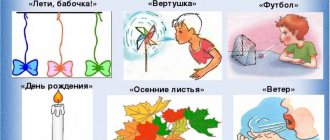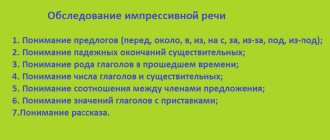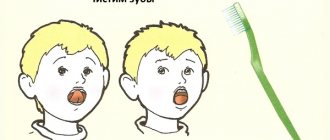What mistakes can there be when trying to pronounce “l”?
The most common mistakes when pronouncing the sound “l”:
- lips are positioned incorrectly, which leads to the pronunciation of other sounds;
- the tongue does not touch the palate, but is pulled inside the oral cavity (the sound “y” is obtained);
- When pronouncing the letter “l,” the child inhales sharply.
Usually, children learn to pronounce the sound “r” one of the last. But if its pronunciation is worked out earlier than “l”, a replacement can be made. That is, instead of the word “spoon” the child says “horn”. True, such cases are rarely observed.
Incorrect lip position
When the lips are strongly elongated, at the moment of pronouncing the letter “l” one hears “v” or “u”. In this case, the parent of a preschooler can independently correct the pronunciation of the consonant sound. An exercise in which you need to tightly clench your upper and lower teeth, smile broadly, spreading your lips, is especially helpful.
If the problem in pronouncing the letter “l” is associated with incorrect positioning of the lips, speech therapy exercises for children will help:
- “Fatigue” - inhale deeply through your nose and exhale through your mouth, lips relaxed and slightly open at the moment of breathing.
- “Fish” - clap your relaxed lips, like a fish thrown ashore.
- “Horse” - inhale through your nose, exhale through your mouth, the air passes through relaxed lips with the sound “prr”.
How eye exercises work
Eye exercises not only help to get rid of the symptoms of fatigue: it is often prescribed by ophthalmologists for vision disorders - myopia, farsightedness and astigmatism. Eye training can be used to prevent vision deterioration, and it is best to start doing it right from childhood. There are a large number of exercise options, but they are all aimed at solving the following problems:
- relaxation of the eye muscles;
- improved focusing;
- stimulation of the lacrimal glands (which is especially useful against dry eyes);
- improving blood circulation and oxygen saturation of tissues;
- elimination of symptoms of nerve spasms and visual discomfort.
Despite the effectiveness of exercises for improving vision, they have contraindications:
- infectious diseases and inflammation - gymnastics can increase pain;
- retinal detachment - doing eye exercises with this diagnosis is simply dangerous, since blood flow to the eyes can lead to retinal rupture;
- rehabilitation period after eye surgery - during this time the eyes need complete rest.
In any case, if you have any doubts or experience discomfort during gymnastics, you should consult a doctor who will select an individual level of stress for you based on your medical history and advise you on how to train correctly.
What is lambdacism and paralambdacism?
Incorrect production and automation of the sound “l” or its complete absence is scientifically called lambdacism. It comes in 4 types:
- nasal - during the pronunciation of a sound, the air flow passes not through the oral cavity, but through the nasal cavity (the root of the tongue covers the throat), instead of “l” the sound combinations “ng” are obtained;
- bilabial - the lips are arranged in a tube, the “u” is heard;
- interdental - instead of the upper palate, the tip of the tongue appears in the gap between the teeth;
- complete absence of “l” - this letter is simply missing from the words.
In the practice of speech therapists, another term is known - paralambdacism. This is the replacement of “l” with other sounds. For example, instead of this consonant letter, the child pronounces “b” or “v”, “g”, “d” and others.
Pronunciation L: norm and deviations
For correct articulation, it is necessary that the teeth are not clenched and there is a gap between them. The tip of the tongue is slightly tense and touches the gums of the upper front teeth; it is lowered in the middle and on the sides, and slightly raised at the base. A stream of air comes from both sides between the tongue and cheeks. The vocal cords are used, which give the sound a ringing quality.
Incorrect pronunciation is possible when the position of the speech organs is disturbed:
- the tongue goes too deep into the oral cavity, and its tip does not touch the gums and upper teeth. Instead of L it turns out Y (“shovel” - “yopata”);
- at the moment of pronunciation, a sharp inhalation occurs and the cheeks are involved in the process - it turns out F;
- The lower lip is close to the upper teeth, the tip of the tongue lies at the bottom of the mouth. The result is the sound B (“came” - “stitch”);
- When you exhale, the air flows through your nose. A sound similar to “ng” (“lamp” - “ngampa”) comes out;
- the labial muscles tense instead of the tongue muscles - bilabial pronunciation. It turns out U instead of L (“boat” - “boat”);
- interdental sound is noted. It sounds almost the same as a regular L, but the tip of the tongue is located between the teeth, and not behind the upper incisors.
It is also possible to replace L with D, Y, soft L (“class” - “class”) or complete loss of sound (“fox” - “isa”). In some cases, they first put R, and then - then the child says instead of “moon” - “rune”, and then they put L.
Formation of correct pronunciation of sounds
In the absence of diseases that are associated with pathologies of the speech apparatus, the pronunciation of the sound “l” can be corrected while performing special speech therapy exercises. They are easy to do at home. In some cases, only a specialist can solve the problem. For dysarthria, which is associated with damage to the nervous system, you will need the help of a neurologist.
Step-by-step home training aimed at correct pronunciation of “l”:
- Strengthening the motor skills of the articulatory apparatus. In this case, special exercises and games will help achieve the desired effect.
- Sound production. Depending on the cause of the defect, a specific method has been developed.
- Accurate pronunciation. Combination of "l" with other letters. First you need to pronounce the syllables, and then the words.
- Poems and tongue twisters for speech development. They will help not only quickly learn the correct pronunciation of sounds, but also develop memory.
At the end, you should consolidate the result obtained by learning songs, fairy tales, and retelling them.
Preparing for “L” placement exercises
Improving the mobility of the muscles of the tongue and lips is the first step in restoring speech development. Preparation for exercises on placing the “l” is as follows:
- licking the upper lip with the surface of the tongue, moving it from top to bottom and holding the lower lip motionless;
- movements similar to the previous exercise are performed, but at an accelerated pace and with the pronunciation “bl”;
- click the tongue on the upper palate near the teeth, the lower incisors remain motionless, the mouth is slightly open;
- smile widely with your mouth slightly open, count during training: one - the tip of the tongue rests on the upper teeth, two - on the lower teeth (alternately);
- the tongue rests on the palate until the frenulum is tensioned.
These exercises help with any type of incorrect pronunciation of “l”. They must be completed for at least two weeks. According to the recommendations of a speech therapist, the duration of training can be increased to a month.
Staging methods
First, the articulation of a soft sound is honed, and then a hard one. They use various methods of production: by imitation, mechanical, from other sounds, as well as breathing and articulation exercises. Individual staging is always more effective than working in a group.
By imitation
This is the most common and simplest staging technique and can be done at home. It is necessary to show several times how to correctly position the tongue and lips when pronouncing L correctly. Then the child repeats. To control, touch your cheeks - they should vibrate slightly.
With this setting, the child is asked to feel a warm wave of air on the palm of his hand when pronouncing sounds. Pictures depicting the letter itself and the articulation technique are useful - a visual image helps to quickly master the skill.
Mechanical method
This is a widely used method. Mechanical placement involves the use of auxiliary means - fingers, a spatula, a probe, a wooden stick or the handle of a teaspoon to fix the speech organs in the correct position.
Possible correction options:
- You can create the necessary space between the sides of the tongue and the upper teeth for the correct direction of the air stream using a wooden stick placed across the tongue;
- Holding your lips in a smiling position with your fingers will help correct U to L with bilabial pronunciation;
- Pressing the pad of the thumb or the back of the hand on the dimple under the chin allows you to get a hard sound when pronouncing a soft one.
With a light massage with your fingertips it is easy to relax facial muscles.
From other sounds
In speech therapy there is a method of setting from A. The child pulls out the vowel and pushes the tongue between the teeth, then bites it in the middle. The sound A turns into a solid sound L.
It is possible to set a hard sound L through Y. You need to lightly bite the tip of your tongue and make the Y sound. If everything is done correctly, L will be heard.
There is a more complex variation. The tongue lies halfway between the teeth. You need to start exhaling forcefully. First we do it silently, then we add voice. We hear a noisy hard sound L, which over time becomes clear and distinct.
How to teach a child to say the letter L?
It is better to work with your child in a playful way. For him, doing exercises should not be a burden. When children do them with pleasure, the result is achieved faster.
Before you start doing independent exercises at home, you should sign up for an individual lesson with a speech therapist. The specialist will talk with the child and, based on the conclusions drawn, will develop a technique that will help in a specific situation, and will also give useful recommendations for correcting the pronunciation of “l”.
Articulation gymnastics
The main method for correcting the pronunciation of the sound “l” is articulatory gymnastics. As a rule, its duration does not exceed 15-20 minutes; the exact time depends on the age of the child. Articulatory gymnastics consists of step-by-step execution of certain elements that should not only be effective, but also arouse interest in the baby.
Articulation gymnastics includes:
- exercises used to develop speech breathing;
- pronunciation automation tasks.
Exercises to improve speech hearing
To improve a child’s speech hearing, speech therapists use special exercises presented in the form of games:
- “Speak louder and quieter” - depending on the size of the toy being shown, you need to speak loudly or quietly;
- “Find the mistake” - the child is shown a picture, deliberately naming it with mistakes; if the baby notices it, he must clap his hands;
- “Guess whose voice!” − an adult dramatizes the voices of animals, and the child must guess which one belongs to whom;
- “Choose one word!” − the speech therapist shows a picture and lists words, the child must choose the one that matches the image.
To stage the sound “l” step by step, regular training with exercises of varying complexity and music classes are required.
Mimic gymnastics
During facial gymnastics, the entire articulatory apparatus, which is directly involved in the pronunciation of sounds, is trained.
The adult shows the pictures and says what is shown on them, and the child plays with facial expressions:
- “Here is a little fox. And this is an adult moose. Look how much he has grown” - the baby should show surprise;
- “The cat was given milk, he laps it up. And Polina is smiling sweetly on the side” - the child must show how the cat drinks milk and the girl’s smile;
- “Little Masha was crying, she lost her porridge” - the baby shows how the girl cries.
Mimic gymnastics also includes exercises with a small ball with a cord threaded through it:
- catch the ball with your mouth without using your hands;
- push the ball with your tongue;
- push out with your lips, making some effort;
- pronounce tongue twisters with a ball in your mouth.
Another type of facial exercise is using a spoon:
- take a small spoon into your fist, place it in your mouth and push with your tongue, try to turn it in different directions;
- lightly tap the tongue with a spoon;
- Use a spoon to outline the oval of your lips, having previously folded them into a tube.
Breathing exercises
To make the sound “l”, breathing exercises are performed, which includes two main exercises:
- short breath for 1 second;
- long, slow exhalation for 3 or 5 seconds.
A few more exercises from the breathing exercises complex:
- inhale, relax your lips and slowly release air through them with the sound “prr”;
- lie on the floor, place your hands on your stomach, inhale, inflating your stomach, exhale - your stomach has decreased in size;
- The adult gives the child a sniff of something from the food, he inhales, and at the exit names the product.
Simple breathing exercises in combination with other methods can make the sound “l”.
Don't forget to warm up
Warm-up is no less important than the workout itself. It helps the body to properly prepare for upcoming stress, even if it is short-term. In addition, warming up allows you to avoid injuries that can occur if the muscles were not toned and “warmed up” before starting the exercises. 10-15 minutes for warm-up
.
Warm-up exercises should be performed at an average pace
, without sudden movements and jerks. Remember that not only physical fitness is important, but also morale, so to warm up, turn on your favorite music or think about something pleasant. We offer a set of simple exercises for self-training at home.
Raise your knees to your elbows
This simple exercise is performed from a standing position. Before starting the exercise, stand straight, place your feet shoulder-width apart to make it easier to maintain balance, then begin to raise your knees and at the same time tilt your body so that the knee of one leg touches the elbow of the opposite arm. There is no need to rush, the pace should be comfortable.
The exercise is performed in several approaches of 1-2 minutes each. It is recommended to do 5 sets in total with a 30-second break between them. The exercise is aimed at strengthening the heart and respiratory system.
Let's get into plank position
Another universal exercise. At first glance, nothing special, but if you do the “plank” correctly, you can strengthen the muscles of the arms, legs and abdomen. The versatility of the exercise is that it can be performed without special training and equipment, and the load can be easily adjusted by the duration of each approach.
When doing the plank, you need to remember that your position must correspond to the name of the exercise. The emphasis is on the forearms and toes. The elbows should be positioned strictly under the shoulders, and the hips should not fall or rise above the level of the head. You can stand in the plank as long as you have the strength to maintain the correct position. The exercise is also recommended to be performed in several approaches with half-minute breaks between them.
Strengthening your back
One of the exercises to strengthen the back muscles is performed from a lying position. You need to lie on your stomach, preferably using a gymnastic mat for this, and begin to bend your back. You cannot push off the floor with your hands; your hands should be bent at the elbows and touch your ears. The lower part of the body along with the legs should remain on the floor. The upper body should be lifted off the floor as much as possible, and then smoothly lowered back.
You should not “fall” on the floor, this will reduce the effectiveness of the exercise, since in this case you will only work “up”, and in the first case also “down”. It would be optimal to perform 5 approaches and 15-20 repetitions in each session in one workout.
Squat
A basic exercise that everyone knows, but not everyone knows how to perform it correctly. Before starting the exercise, stand straight, place your feet shoulder-width apart, and place your feet slightly apart. Start squatting. You need to squat as deep as you can. In this case, you need to make sure that your heels do not lift off the floor and that your body does not lean forward. You can squat as many times as your physical fitness allows. Squats primarily help strengthen the muscles of the legs, as well as the muscles of the buttocks.
Stretching the muscles of the back and sides
This exercise is performed from the “baby pose”. To take the starting position, you need to kneel down and sit on your heels, and then smoothly and slowly lower your stomach to the front of your thighs. At the same time, you need to stretch your arms forward as far as possible to stretch the muscles. At the farthest point you need to linger for 20-30 seconds and then return to the starting position. With this exercise you can effectively stretch the muscles of your back, shoulders, and sides.
Squatting with a chair
For this exercise you will need a simple prop: a chair. You need to turn your back to the chair and rest your hands on the seat. In this case, your legs should be about half a meter from the chair so that the main emphasis falls on your hands. This exercise requires you to actually do a push-up: bend your elbows, lower your hips, and then straighten your arms. As a result, you can strengthen your triceps.
Doing backward lunges
This exercise should be started when the muscles are already warmed up. You will need a little more space to avoid accidental injuries. Starting position: stand straight, spread your arms to the sides to maintain balance. Take a big step back with one leg and bend the other leg at the knee. Get down as low as possible, then push off with your back leg to return to the starting position. If you do everything correctly, then you should not move relative to the starting position. After each lunge, there is an alternating change of legs. In general, the exercise is useful for developing coordination and balance.
Checking the “King’s thrust”
Another exercise on our list that helps strengthen the muscles of the legs and buttocks. Performed from a standing position. One leg should be taken back and placed on the toe, the center of gravity should be transferred to the front leg. Then begin to slowly lean forward, bending your leg at the knee, until you can touch the floor with your fingers. When the goal is achieved, you need to return to the starting position by straightening your leg. The exercise should be performed 10-15 times in one approach. There can be several approaches, but you must take at least short breaks between them.
Let's get on the bridge
A very famous exercise to strengthen the buttocks is performed from a supine position. The feet need to be pressed firmly to the floor to better maintain balance, fix the knees above the heels and begin to slowly lift the hips off the floor, raising them to a comfortable height. The main thing in this exercise is not the height of the lift or the speed of its execution, but correctness. It is recommended to perform 5 approaches and 10-15 exercises in each of them in one workout.
Introducing ourselves as Superman
You can finish your workout with a superhero exercise. You won't have to fly, although it all depends on your imagination. To perform the exercise, you need to get down on all fours, and then alternately lift and stretch forward one arm and the opposite leg. Don't rush, so as not to lose your balance. For this exercise, one approach is enough, but you will have to perform it 30-40 times. The muscles of the abdomen, buttocks and back will be involved.
How to make correct pronunciation automatic?
Making the sound “l” at home is not always a simple task. Sometimes this takes a lot of time, and sometimes you can’t do it without the help of a specialist.
The main thing is to avoid overload, because for a child even 40 minutes of studying a day may seem like hard work. Workouts should be fun and relaxed, making them easier to handle if they are treated as play rather than work. It is enough to conduct 2 classes daily for a few minutes each.
Soft "l"
What is noteworthy is that even after a child learns to pronounce the sound “l”, he can continue to omit it in words. In this case, you need to produce a soft sound - “l”. It is advisable to start training first with syllables and only then move on to full words (le - swan, lyu - cradle).
Pure sayings like “li-li-li – we found mushrooms” and others are useful. Tongue twisters will also be useful:
- “At the warm stove, Anatoly is weaving bast shoes”;
- “Little Valentine boots for the giant”;
- “Lala was eating halva under the blanket.”
When straight syllables with a soft “l” are obtained, it is worth moving on to the next stage of learning - the pronunciation of reverse syllables, such as “ul”, “al” and others. Next - pronouncing words - moth, poplar, tulip and others.
When placing a soft “l”, you need to ensure that the tongue is positioned correctly in the mouth.
Hard "l"
According to speech therapists, the production of the sound “l” from “l” is characterized by increased complexity. Teaching a child to say a solid letter is somewhat more difficult and takes longer. However, the technique does not abandon the previous one, it just requires more repetitions.
It is advisable to start with the syllables “la”, “lu”, “lo” and others. Then you can move on to the words: “bow”, “boat” and others.
And this is where tongue twisters and pure tongue twisters come in handy:
- “Lu-lu-lu - sweep up the ashes”;
- “Volodka is in the boat.”
When learning to pronounce hard and soft “l”, you should avoid words with the letter “r”, as the child may get confused.
Sound Automation
After speech therapy, it is important to introduce sound into everyday speech. Fix L first in an independent sound, and then in syllables and words. The secret of the production is in the most comfortable and interesting format - using games, tongue twisters, rhymes, riddles containing words with the desired hard and soft sound.
Examples of using L in syllables, words, tongue twisters:
- syllables: la, klya, lyu, flu, li, gli, le, ple, ol, spruce;
- words: fields, fox, laziness, boat, spoon, drops;
- tongue twisters: “La-la-la - cold earth”, “Spruce-spruce - there are drops outside the window.”
Audio automation is done in stages. Gradually lead your child to compose stories based on pictures or their own memories.
Differentiation L
Staging classes are not the final stage. It is important that the child distinguishes L from similar sounding phonemes. L is differentiated separately, as well as in words and sentences.
We offer the following options for games and activities for individual production:
- “Remember and repeat.” The child is offered cards with printed syllables with the letters L, R, V: ra-la, ru-lu, al-ar, ul-ur, la-va, ul-uv, etc. Cards with words and sentences are gradually added;
- "Find the words in the picture." The baby names words with the letters V, R, L, for example, “watermelon”, “spoon”, “cheese”, “bucket”;
- “Fill in the missing syllables and words.” The child is offered a text with ready-made poems and proverbs, where syllables containing L, R, V are deliberately omitted.
The differentiation of “l” and “l” is carried out according to the same principle - the child learns to distinguish between words with soft and hard sounds. For example, “boat-summer”, “moth-chalk”.
Help from a speech therapist
Up to 5 years of age, incorrect pronunciation of certain sounds is considered normal. But in the sixth year of life, the baby already needs the help of specialists. First, you can try to correct the situation at home; if you cannot cope on your own, you should contact a speech therapist.
The first speech therapy session will help determine the cause of the incorrect pronunciation of the sound. This will help develop an effective technique that is suitable for a particular child. In some cases, assistance from other specialists may be required.
Sometimes a mechanical method of producing the sound “l” is used - using probe No. 4.
Etiology of disorders
Incorrect pronunciation can be a sign of either dyslalia (a simple speech disorder) or more serious speech disorders. The emergence of lambdacisms and paralambdacisms is due to the following reasons:
- violation of muscle tone of the tongue;
- immaturity of articulation organs;
- phonemic hearing impairment;
- incorrect speech environment in which the child grows up.
The speech therapist determines the cause during the diagnosis, which he conducts before the start of classes. And based on the results, the specialist selects a set of suitable corrective exercises.
Games to strengthen pronunciation
After a long learning process, the final stage follows - consolidating the pronunciation of the sound “l”.
In this case, the following games will help:
- come up with about 30 small sentences, each word of which must contain the letter “l” (The doctor is treating Lola, Leaves are flying on the windshield), you should pronounce them together with the child, gradually accelerating the pace;
- invite the child to complete a phrase like “My sister paints her nails not with paint, but with ... (varnish)”, “The house became dark because they turned off ... (the lamp), the last word of the phrase must contain “l.”
At the final stage, when consolidating the pronunciation of the sound “l,” tongue twisters and tongue twisters also help. When the child begins to pronounce them correctly, clearly pronouncing each sound, you can begin to study poems.









